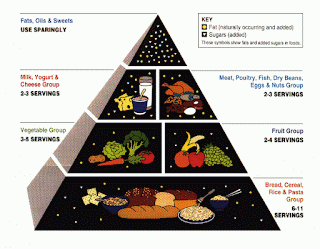Food pyramids have been around for decades. The first pyramid was published in Sweden in 1974. However, the most widely known food pyramid was introduced by the United States Department of Agriculture (USDA) in 1992 (pictured on the left), was updated in 2005 and then replaced in 2011 by "my plate", which is only a slightly bettered version of the food pyramid.
Many nutritional experts, such as Harvard nutritionist Dr. Walter Willett, believe the 1992 pyramid does not reflect the latest research in dietetics. Technically the pyramid allowed dietary choices that have been linked to heart disease: three cups of whole milk and one 230g hamburger daily - for example.
The fats group as a whole have been put at the tip of the pyramid with a warning to eat as little as possible, which is problematic in itself. If you take the pyramid at face value you would believe that you should avoid the fats group as much as possible - this could lead to the health problems. Fat is essential to maintain optimum health. Research has found that unsaturated fats aid in weight loss, reduce heart disease risk, lower blood sugar and even lower cholesterol. This type of fat can be found in olive oil, nuts, seafood, and avocados. Also, they keep you feeling satisfied for longer, and help keep blood sugar at steady levels and help brain function.
However, one of the most worrying parts of the food pyramid released by the USDA is the widest section at the bottom suggests that what we should eat the most of is grains, pasta and breads despite the evidence showing that grains break down into sugar in your body and therefore promote fat accumulation and drives insulin resistance and related diseases including diabetes, heart disease and cancer.
So why grains? They are cheap and easy to grow and they are also cheap and easy to buy, you can feed more people cheaply with grains than growing vegetables or raising cattle.
Saturated fat has always had a bad name too, but there is also mounting evidence that saturated fat is actually an incredibly healthy, nourishing, and all-natural fat that we humans have been thriving on for generations. Saturated fats when included in the diet, give lots of energy and leave you feeling satisfied for longer therefore preventing you from eating too much. They are also necessary for the absorption of fat soluble vitamins such as vitamins A, D, E and K and are also needed for mineral absorption and many biological precesses. (For more information on this type of fats you can see my post The Truth About Saturated Fats).
Dr. Mercola has designed a food pyramid based on Nutritional Science - which would promote optimal
health. He believes, and I am inclined to agree with him, that the USDA pyramid is based on agricultural subsidies and industry lobbying efforts. His pyramid is almost like turning the USDA pyramid upside down. He features healthful fats and vegetables on the bottom - the base for what we should all be eating. 50% of our daily calorie intake should come from healthful fats and vegetables such as, avocados, coconut oil, nuts and raw butter. Vegetables should represent the main bulk of your daily intake, they are low in calories but high in a huge number of critical nutrients.
He then goes on to suggest high quality proteins, followed by a moderate amount of fruits. Why so few fruits? Well according to Mercola, lots of fruits are very high in fructose, the natural sugar found in fruit, and Mercola would really prefer we stay as far away from fructose as possible. Here I am in two minds... yes, if you eat lots of fruits with a high fructose content it is possible that you will have to deal with health problems, however, Mercola's main problem seems to be with High Fructose Corn Syrup which has been highly processed and is completely different from the natural Fructose found in fruits. The human body has ways of digesting the natural fruit fructose, as with everything - just don't over do it! There are plenty of tables on the Internet which show the content of fructose in different fruits. My advice would be to keep the high fructose fruits to a minimun and in the mornings to give you an energy boost through the day, and lower fructose fruits in the afternoon evening when you don't need so much energy.
Finally at the very top of Mercola's pyramid you'll find grains and sugars. This top part could be eliminated entirely from your diet and he assures your health will benefit greatly is you chose to do so.
Apart from the fructose question, I totally agree with Mercola's pyramid. I highly recommend you read his article in full, you can follow this link to read it: Dr Mercola's article.
Social Nutrition:
You can make an appointment to improve your health with Social Nutrition either in person (Madrid) or online (Skype). Just send an email to lucycarr@socialnutrition.com



No comments:
Post a Comment